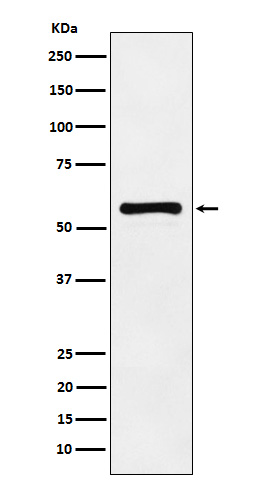产品名称
PAK2 (16A19) Rabbit Monoclonal Antibody
别名
CB422; Gamma PAK; hPAK65; p27; p34; p58; p65PAK; PAK-2p34; Pak2; PAK65; PAKgamma; S6 H4 kinase;
纯度
Affinity-chromatography
存储缓冲液
Supplied in 50mM Tris-Glycine(pH 7.4), 0.15M NaCl, 40%Glycerol, 0.01% New type preservative N and 0.05% BSA.
Human Swissprot No.
Q13177
免疫原
A synthetic peptide of human PAK2
稀释度
WB: 1:1000 IHC: 1:20-1:100 ICC/IF: 1:20-1:50 FC: 1:20
注意事项
PAK2 Antibody is for research use only and not for use in diagnostic or therapeutic procedures.
组织表达
Ubiquitously expressed. Higher levels seen in skeletal muscle, ovary, thymus and spleen
细胞定位
[Serine/threonine-protein kinase PAK 2]: Cytoplasm. Note=MYO18A mediates the cellular distribution of the PAK2- ARHGEF7-GIT1 complex to the inner surface of the cell membrane
功能
Serine/threonine protein kinase that plays a role in a variety of different signaling pathways including cytoskeleton regulation, cell motility, cell cycle progression, apoptosis or proliferation. Acts as downstream effector of the small GTPases CDC42 and RAC1. Activation by the binding of active CDC42 and RAC1 results in a conformational change and a subsequent autophosphorylation on several serine and/or threonine residues. Full-length PAK2 stimulates cell survival and cell growth. Phosphorylates MAPK4 and MAPK6 and activates the downstream target MAPKAPK5, a regulator of F-actin polymerization and cell migration. Phosphorylates JUN and plays an important role in EGF-induced cell proliferation. Phosphorylates many other substrates including histone H4 to promote assembly of H3.3 and H4 into nucleosomes, BAD, ribosomal protein S6, or MBP. Additionally, associates with ARHGEF7 and GIT1 to perform kinase-independent functions such as spindle orientation control during mitosis. On the other hand, apoptotic stimuli such as DNA damage lead to caspase- mediated cleavage of PAK2, generating PAK-2p34, an active p34 fragment that translocates to the nucleus and promotes cellular apoptosis involving the JNK signaling pathway. Caspase-activated PAK2 phosphorylates MKNK1 and reduces cellular translation.

